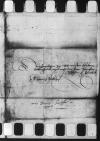Letter #5028
Albrecht I von Hohenzollern-Ansbach to Ioannes DANTISCUSKönigsberg (Królewiec), 1541-06-02
| received Heilsberg (Lidzbark Warmiński), 1541-06-12 Manuscript sources:
Auxiliary sources:
Prints:
| ||||||||||
Text & apparatus & commentary Plain text Text & commentary Text & apparatus
Dem erwirdigenn inn Gott, unnserm besondernn liebenn freundt unnd nachparnn, herrn
Unnser freuntlich dinst zuvor. /
Erwirdiger inn Gott besonder lieber freundt unnd nachpar.
Unns hatt der edell unnser lieber getreuer
Dat(um)
Vonn Gots gnadenn


 BCz, 1606, p. 584
BCz, 1606, p. 584